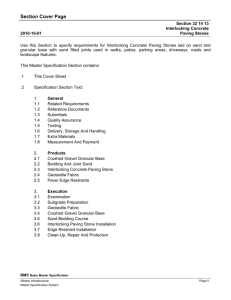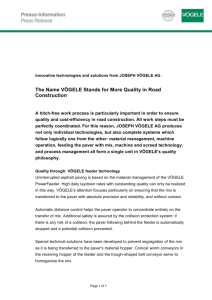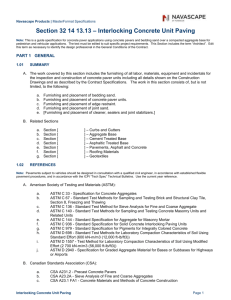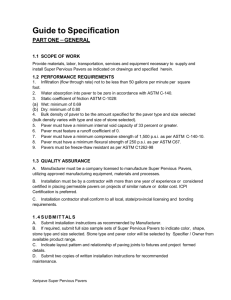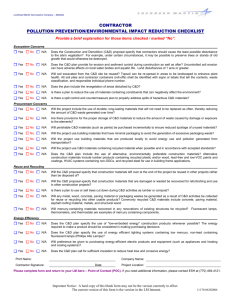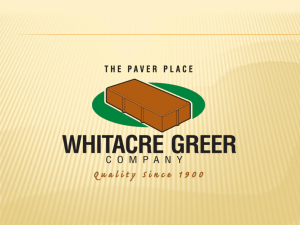SECTION 02780 - INTERLOCKING PAVING STONES Page 1 of 3
advertisement
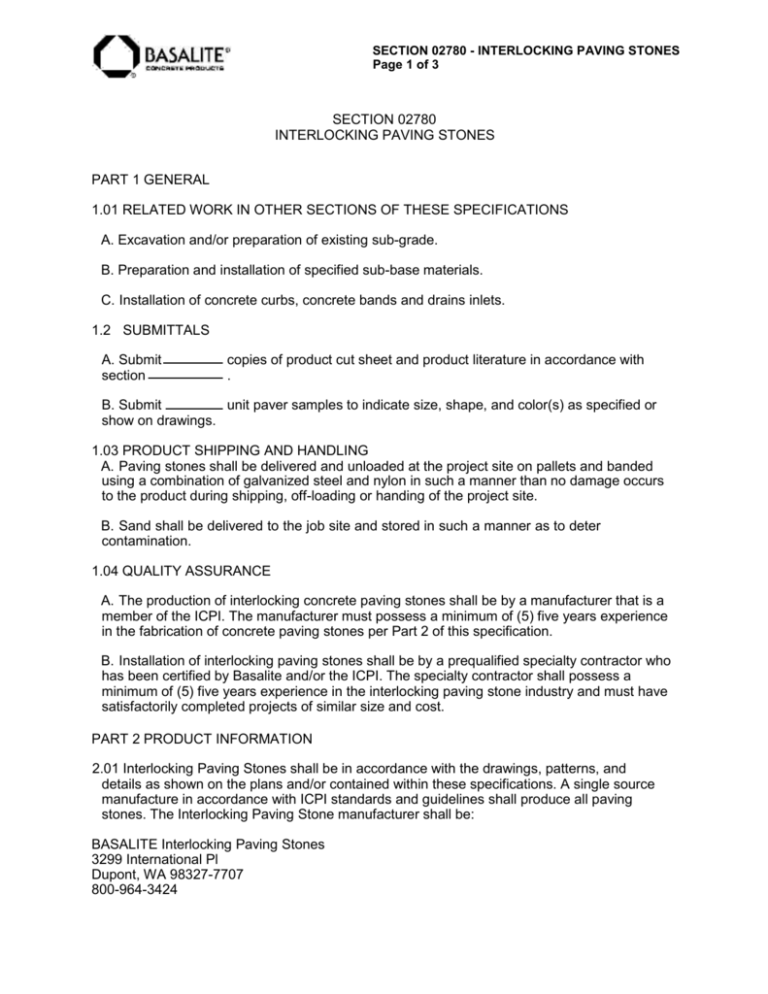
SECTION 02780 - INTERLOCKING PAVING STONES Page 1 of 3 SECTION 02780 INTERLOCKING PAVING STONES PART 1 GENERAL 1.01 RELATED WORK IN OTHER SECTIONS OF THESE SPECIFICATIONS A. Excavation and/or preparation of existing sub-grade. B. Preparation and installation of specified sub-base materials. C. Installation of concrete curbs, concrete bands and drains inlets. 1.2 SUBMITTALS A. Submit section copies of product cut sheet and product literature in accordance with . B. Submit unit paver samples to indicate size, shape, and color(s) as specified or show on drawings. 1.03 PRODUCT SHIPPING AND HANDLING A. Paving stones shall be delivered and unloaded at the project site on pallets and banded using a combination of galvanized steel and nylon in such a manner than no damage occurs to the product during shipping, off-loading or handing of the project site. B. Sand shall be delivered to the job site and stored in such a manner as to deter contamination. 1.04 QUALITY ASSURANCE A. The production of interlocking concrete paving stones shall be by a manufacturer that is a member of the ICPI. The manufacturer must possess a minimum of (5) five years experience in the fabrication of concrete paving stones per Part 2 of this specification. B. Installation of interlocking paving stones shall be by a prequalified specialty contractor who has been certified by Basalite and/or the ICPI. The specialty contractor shall possess a minimum of (5) five years experience in the interlocking paving stone industry and must have satisfactorily completed projects of similar size and cost. PART 2 PRODUCT INFORMATION 2.01 Interlocking Paving Stones shall be in accordance with the drawings, patterns, and details as shown on the plans and/or contained within these specifications. A single source manufacture in accordance with ICPI standards and guidelines shall produce all paving stones. The Interlocking Paving Stone manufacturer shall be: BASALITE Interlocking Paving Stones 3299 International Pl Dupont, WA 98327-7707 800-964-3424 SECTION 02780 - INTERLOCKING PAVING STONES Page 2 of 3 2.02 MANUFACTURING & EFFLORESCENCE CONTROL A. Method of manufacturing paving stones to be single-layer production to insure dimensional uniformity, optimum color blending and product strength and durability. Colors are to be integral throughout unit paver or face-mixed concurrent to project conditions. Multi-layer paver machines and/or block production machines are not acceptable and shall be cause for rejection. B. Efflorescence must be minimized with the utilization of a water purification system. The water purification system shall have a minimum water capacity of 160 gallons per minute during paving stone batching cycle. Minimum capacity of (3) three admixture controls to reduce efflorescence and improve quality and texture. 2.03 MATERIALS A. Interlocking Paving Stones shall conform to the following specifications: 1. Paver shape to be: 2. Paver Color to be: 3. Laying Pattern: Note: Unit pavers from sources other than the specified manufacture must meet or exceed the specified manufacture s color loading. Color loading: Color content to be certified by and independent testing facility. Color pigments shall conform to ASTM C-979. Paving stone substitute samples, no manufactured by the specified source supplier must be approved in writing by the Project Architect, and/or the Owner at least (5) five working days prior to bid or the paving stones substitutions will not be accepted. NO EXCEPTIONS. 4. Paver length and width shall not vary by more than + 1/16" (1.6mm) in unit dimension. Paver height shall not vary by more than (+ 1/8" (3.2mm) from specified standard dimensions. 5. Pavers to have an average minimum compressive strength of 8,000 psi (55 MPA) with no paver testing lower than 7,200 psi (MPA) in accordance with testing procedures ASTM C936, Standard Specification for Interlocking Concrete Paving Units. 6. Average absorption of 5% with no units greater than 7% when tested in accordance with ASTM C-140 and resistance to 50 freeze-thaw cycles in accordance with ASTM C-67. 7. Materials used to manufacture concrete paving stones shall conform to the following: * Cement: ASTM C-150 (Portland Cement) * Aggregate: ASTM C-33 (screened, washed sand and rock, with no expanded shale or lightweight aggregates. B. Sand Bedding Course SIEVE SIZE: 3/8 inch No. 4 No. 8 No. 100 No. 200 Passing: 100% 93-100% 61-100% 1-12% 1-7% SECTION 02780 - INTERLOCKING PAVING STONES Page 3 of 3 1. The thickness of the sand-bedding course should be uniform to insure an even surface after compaction of unit pavers. The maximum designed depth should be (1) one inch thick with no sand thickness less than (3/4"). 2. The installation of the sand-bedding course will be the responsibility of the paving stone contractor. 3. The finished sub-base should be installed to within + (1/2") one-half inch of the following: The unit paver thickness plus the (1") one-inch sand-bedding course from final elevation. PART 3 INSTALLATION OF PAVING STONES 3.01 Do not begin installation of pavers until sub-base has been installed per specifications. 3.02 Screed sand bedding course to recommended depth. Sand is to remain undisturbed prior to the installation of unit pavers. Moisture content of sand should remain constant. 3.03 Unit pavers shall be clean and free of foreign materials before installation. 3.04 Installation shall start from a corner or straight edge, unless detailed otherwise and proceed forward over the undisturbed sand-bedding course. 3.05 Paving work shall maintain proper elevations and slope design. Unit paver surface shall be even, true to line and grade and shall properly coincide and align with adjacent work to elevations. All perimeter edges must be retained to secure the unit pavers and sand-bedding course. A. Unit pavers should be installed tight and level on the sand-bedding course. String lines should be used to hold pattern directions true. No unit paver joint shall be greater than (1/4") inch. No perimeter edge joint should be greater than (3/8"). NOTE: Some pavers shapes are designed with larger joint spacing. B. Cutting of unit pavers shall be done with a double bladed stonecutter or diamond blade masonry saw. C. A plate type vibratory compactor should be used to compact the unit pavers into the sand-bedding course. Two to Three passes are recommended to insure an even elevation. D. Spread dry, angular/fine sand (commonly known as mortar sand) over the compacted unit pavers. Make several passes with the plate compactor, while sweeping the sand into the paver joints. Insure all joints are full before clean up. Excess sand should be swept up and removed from the completed unit paver installation. E. The completed paving stone installation should be swept and washed down to provide a clean, finished, workman-like landscape surface. END OF SECTION

